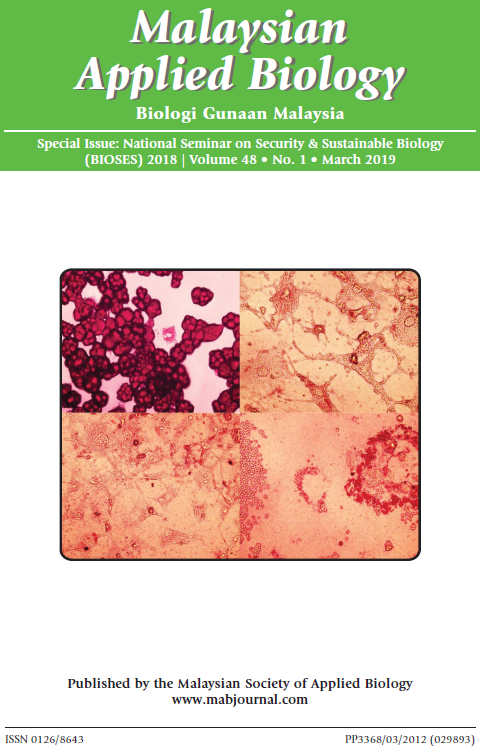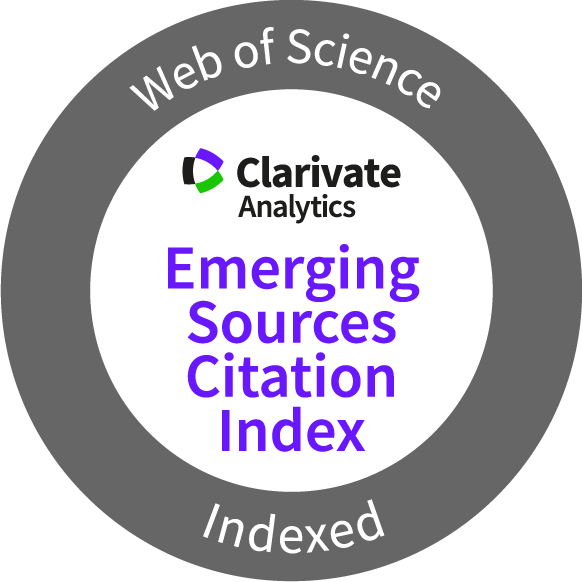ISOLATION AND IDENTIFICATION OF P(3HB-co-4HB) PRODUCING BACTERIA FROM VARIOUS LOCATIONS IN KUALA TERENGGANU
Keywords:
Biomaterial, microbial bioplastics, PHA, P(3HB-co-4HB)Abstract
Polyhydroxyalkanoates (PHA) is a microbial bioplastic accumulated as a storage material under limited growth conditions in the presence of excess carbon sources. The ever increasing concern towards the depletion of petroleum resources and problems with utilization of a growing number of synthetic plastics, PHAs are being considered as a potential substitute for production of conventional non-degradable plastics. PHAs have been developed as biomaterials with unique properties for many years. Among all types of PHA, copolymer poly(3-hydroxybutyrate-co-4-hydroxybutyrate) [P(3HB-co-4HB)] is widely sought after for biomedical application due to the biocompatibility, non-cytotoxicity and non-genotoxicity. Therefore, the aim of this study is to isolate and identify P(3HB-co-4HB) producers from water and soil sources in Kuala Terengganu. Samples of lake and soil were collected during November 2017 and then screened for P(3HB-co-4HB) producer. A total of 18 isolates were obtained, however only 5 isolates were identified as potential PHA producer. Interestingly, 3 isolates were confirmed as copolymer P(3HB-co-4HB) producer through gas chromatography analysis. These 3 isolated identified bacterial strain were Cupriavidus sp. TMT 11 with the highest 4HB molar fraction of 14.1%. The other 2 isolates were Acinetobacter sp. KPD 13 and Cupriavidus sp. PD 16. The properties of the copolymer P(3HB-co-4HB) produced by wide variety of bacteria isolated can be tailored for various biomedical applications.
Downloads
Metrics
References
Ali, I. & Jamil, N. 2016. Polyhydroxyalkanoates: Current applications in the medical field. Frontiers in Biology, 11(1): 19-27.
Amirul, A.A., Yahya, A.R.M., Sudesh, K., Azizan, M.N.M. & Majid, M.I.A. 2008. Biosynthesis of poly (3-hydroxybutyrate-co-4-hydroxybutyrate) copolymer by Cupriavidus sp. USMAA1020 isolated from Lake Kulim, Malaysia. Bioresource Technology, 99(11): 4903-4909.
Amirul, A.A., Yahya, A.R.M., Sudesh, K., Azizan, M.N.M. & Majid, M.I.A. 2009a. Isolation of poly (3-hydroxybutyrate-co-4-hydroxybutyrate) producer from Malaysian environment using γ-butyrolactone as carbon source. World Journal of Microbiology and Biotechnology, 25: 1199-1206.
Amirul, A.A., Yahya, A.R.M., Sudesh, K., Azizan, M.N.M. & Majid, M.I.A. 2009b. Microbial synthesis of poly (3-hydroxybutyrate-co-4- hydroxybutyrate) by Cupriavidus sp. USMAA1020 isolated from Malaysian environment. Innovations in Chemical Biology, 187-195.
Aziz, N.A., Huong, K.H., Sipaut, C.S. & Amirul, A.A. 2017. A fed-batch strategy to produce high poly (3-hydroxybutyrate-co-3-hydroxyvalerate-co- 4-hydroxybutyrate) terpolymer yield with enhanced mechanical properties in bioreactor. Bioprocess and Biosystems Engineering, 1-14.
Braunegg, G., Sonnleitner, B. & Lafferty, R.M. 1978. A rapid gas chromatographic method for the determination of poly-β-hydroxybutyric acid in microbial biomass. European Journal of Applied Microbiology and Biotechnology, 6(1): 29-37.
Chee, J.W., Amirul, A.A., Muhammad, T.T., Majid, M.I.A. & Mansor, S.M. 2008. The influence of copolymer ration and drug loading level on the biocompability of P (3HB-co-4HB) synthesized by Cupriavidus sp. (USMAA2-4). Biochemical Engineering Journal, 38(3): 314-318.
Huong, K.H., Azuraini, M.J., Aziz, N.A. & Amirul, A.A. 2017. Pilot scale production of poly (3- hydroxybutyrate-co-4-hydroxybutyrate) biopolymers with high molecular weight and elastomeric properties. Journal of Bioscience and Bioengineering, 1-8.
John, M.J. & Thomas, S. 2008. Biofibres and biocomposites. Carbohydrate polymers, 71(3): 343-364.
Koller, M., Bona, R., Chiellini, E., Fernandes, E.G., Horvat, P., Kutschera, C., Hesse, P. & Braunegg, G. 2008. Polyhydroxyalkanoate production from whey by Pseudomonas hydrogenovora. Bioresource Technology, 99: 4854-4863.
Kunioka, M., Tamaki, A. & Doi, Y. 1989. Crystalline and thermal properties of bacterial copolyesters: Poly (3-hydroxybutyrate-co-3 hydroxyvalerate) and poly (3-hydroxybutyrate-co-4-hydroxybutyrate). Macromolecules, 22(2): 694-697.
Mikkili, I., Karlapudi, A.P., Venkateswarulu, T.C., Babu, D.J., Nath, S.B. & Kodali, V.P. 2014. Isolation, screening and extraction of polyhydroxybutyrate (PHB) producing bacteria from sewage sample. International Journal of PharmTech Research, 6: 850-857.
Mukai, K., Yamada, K. & Doi, Y. 1994. Efficient hydrolysis of polyhydroxyalkanoates by Pseudomonas stutzeri YM1414 isolated from lake water. Polymer Degradation and Stability, 43: 319-327.
Norhafini, H., Thinagaran, L., Shantini, K., Huong, K.H., Syafiq, I.M., Bhubalan, K. & Amirul, A.A. 2017. Synthesis of poly (3-hydroxybutyrate-co-4-hydroxybutyrate) with high 4HB composition and PHA content using 1,4-butanediol and 1,6-hexanediol for medical application. Journal of Polymer Research, 24: 1-9.
Odham, G., Tunlid, A., Westerdahl, G. & Marden, P. 1986. Combined determination of poly-β- hydroxyalkanoic and cellular fatty acids in starved marine bacteria and sewage sludge by gas chromatography with flame ionization or mass spectrometry detection. Applied and Environmental Microbiology, 52(4): 905-910.
Rawte, T., Padte, M. & Mavinkurve, S. 2002. Incidence of marine and mangrove bacteria accumulating polyhydroxyalkanoates on the mid-west coast of India. World Journal of Microbiology and Biotechnology, 18: 655-659.
Spiekermann, P., Rehm, B.H., Kalscheuer, R., Baumeister, D. & Steinbüchel, A. 1999. A sensitive, viable-colony staining method using Nile red for direct screening of bacteria that accumulate polyhydroxyalkanoic acids and other lipid storage compounds. Archives of Microbiology, 171: 73-80.
Wang, J.G. & Bakken, L.R. 1998. Screening of soil bacteria from poly-β-hydroxybutyric acid production and its role in the survival of starvation. Microbial Ecology, 35(1): 94-101.
Yellore, V. & Desai, A. 1998. Production of poly-3-hydroxybutyrate from lactose and whey by Methylobacterium sp. ZP24. Letters in Applied Microbiology, 26: 391-394.
Published
How to Cite
Issue
Section
Any reproduction of figures, tables and illustrations must obtain written permission from the Chief Editor (wicki@ukm.edu.my). No part of the journal may be reproduced without the editor’s permission

















